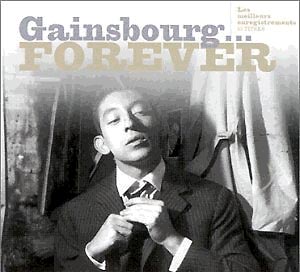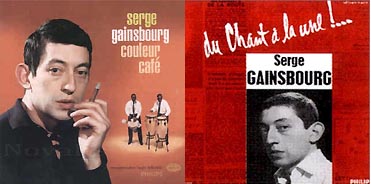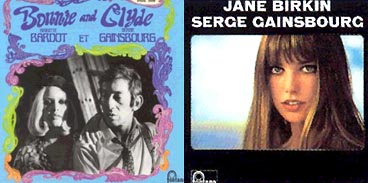Gainsbourg by Gainsbourg
Gainsbourg looks back over his career.
Paris
02/03/2001 -
 The story begins on 2nd April 1928, with the birth of Lucien (later to become Serge) Ginzburg. His parents were Russian Jews who fled to Paris during the revolution. His father Joseph Ginzburg, was a painter and classical musician and made his living as a pianist in Parisian nightclubs. The piano and wireless took pride of place in the family home.
The story begins on 2nd April 1928, with the birth of Lucien (later to become Serge) Ginzburg. His parents were Russian Jews who fled to Paris during the revolution. His father Joseph Ginzburg, was a painter and classical musician and made his living as a pianist in Parisian nightclubs. The piano and wireless took pride of place in the family home.
"I was given a classical music training by my father. The first thing that sent shivers down my spine was Rhapsody in Blue. I've tried to play it - I can play some themes, which are relatively easy from a technical point of view. My sisters and I used to keep a handkerchief to the left of the piano - we always knew that when we'd finish playing a piece, we'd be in tears. My father would always say: "What are you doing! That's not an A flat that's an A major!" I was a good student, but he used to scare me, he was very intimidating. So I'd say "But I didn't do it on purpose! I was concentrating, I did play an A flat!". But that's what learning classical piano is all about, it was good training.
I loved Scarlatti, Brahms and Schuman. My father would make me listen to the wireless. But there was no way any child of his was going to listen to anything other than classical music. We were forbidden to listen to anything else."
In the 1950s, a somewhat unoptimistic Gainsbourg hoped he'd get his break. After dropping out of art school, he gradually left painting aside and turned instead to playing guitar and piano in small cabaret night-clubs in Paris and Normandy. In 1954, he contacted Sacem (the French copyright protection association for songwriters and composers) and registered his first songs with them. A few years later a decisive encounter was to change the direction of his life.
"My father later introduced me to other disciplines, like jazz, and I discovered all the greats: Irving Berlin, Cole Porter and Gershwin. People would criticise Gershwin back then, saying things like: "Hmm, but it's all stolen. He's ripped-off his material from black music". It's sickening. Of course he was influenced by black music! But he was Gershwin!
"I was playing piano in cabaret bars, and I wasn't bad. I had the touch. A lot of bar pianists just bang away at the keys - they're rubbish. I had technique, I'd been trained in the science of pianoforte and I played from the heart. It's the best training you can have - playing in dance halls. I'm not sure if it was wrong of me to abandon such a great art for a second-rate art, but maybe subconsciously, I sensed where my destiny lay."

Serge Gainsbourg's first album, in 25cm format, Du chant à la une, was released in 1958, and featured the famous hit Le Poinçonneur des Lilas and an introductory text written by Marcel Aymé. Three other 25cm formats followed in the period up until 1962, inspired by jazz, roman noir (dark gritty crime novels) and poetry. Shortly afterwards two other albums were released: the jazz inflected Gainsbourg Confidentiel and Gainsbourg Percussions influenced by Afro-Cuban rhythms.
" I was playing guitar and piano in a cabaret on the left bank, an avant-garde place, and who should walk in one night but Boris Vian. At that stage I was completely disillusioned with the whole thing - the second-rateness of it all. Then one night this really pale Boris Vian appears, in this kind of over-exposed light, in the photographic or cinematic sense. When I heard Vian sing, it was incredible, all that contempt. No, contempt isn't the right word, because he was a good guy, an impressive person. I said to myself: "Shit, he's on to something. This is intelligent stuff, this isn't second-rate art." So it was then that I started to write. It was Vian who motivated me.
" My first 25cm was le Poinçonneur des Lilas. The first idea that came to me was: I go down into the dreariness of the subway and I go and talk to a ticket puncher and I say: "Sir, what do you wish for after working all day like this?". And he says to me: "Young man, I want to see the sky". And they were the words, which inspired le Poinçonneur.
A few years later, Brel said something unbelievable to me: he told me "As long as you don't get it, as long as you don't understand who you who are, that is a crooner, you'll never make it." And, in the end, he was right. The most beautiful songs I ever wrote were "crooner" songs: la Javanaise, l'Eau à la bouche, Manon, Dépression au-dessus du jardin."
In the early sixties, the new yé-yé craze (a kind of French pop-rock inspired by rock'n'roll) hit the country and Serge Gainsbourg suffered as a result. Branded as a kind of literary singer, the 35-year-old was not viewed as a successful singer. However, everything was to change when he wrote the ironic Poupée de cire, poupée de son for the young singer France Gall, who went on to win the 1965 Eurovision Song Contest in Naples with the song.
Gainsbourg retired from the stage for a few years to write songs for other singers such as Régine, Mireille Darc, and France Gall again with les Sucettes.
" Yeah, I was having a pretty rough time of it back then - I had this air of a down on his luck songwriter about me. All these young guys with their electric guitars appeared on the scene making life difficult for me. I wouldn't say I was exactly out of the running, but they annoyed the hell out of me because all the young kids back then idolised them and that meant I was in trouble. Luckily, my label didn't drop me - they reckoned I still had potential for making hits. And they were right. But it wasn't until France Gall and Poupée de cire, poupée de son that I had a song which was "on the beat". Then all the walls came tumbling down, the heavens stirred, the windows shattered and I suddenly became a successful artist."
In 1966, London was the centre of the new pop revolution and Gainsbourg went there to record some new tracks. This was to prove a huge turning point in his career and it was at this point that he began to use Anglicisms in his lyrics.
"I wanted the British sound. I'd had enough of "Frenchies". The British sound was a lot cooler, it had a different style. I don't like stagnation. One of my main motivations throughout my career has been my desire to change styles. That's what always drove me. The first version of Comic Strip was recorded in London as a duet with a black singer, like we did for Ford Mustang. She was cool the little black singer on Ford Mustang."

On 3 October 1967, Serge Gainsbourg had lunch with Brigitte Bardot to sort out the plans for an upcoming television show dedicated to the glamorous star. Enamoured, Gainsbourg offered to write her some songs, one of which was to be the steamy Je t'aime… moi non plus (inspired by a Salvador Dali quip).
" I think it was the first porn song ever written in the history of pop music. I was living in the Cité internationale des arts (a residence for artists in Paris) at the time. I was having dinner with Brigitte and deliberately got drunk. She called me the next day and said "Why did you get drunk like that?". And I didn't say anything - my silence kind of saying, "I was overwhelmed by your beauty". And she said to me "Write me the most beautiful love song you can possibly imagine". That night, I wrote Je t'aime moi non plus and Bonnie and Clyde. And we recorded it under intense conditions - there was this incredible passionate tension, the two of us hand in hand with our microphones.
" Then what happens? Little Jane arrives on the scene - with all her Britishness. Young Jane - I gave her the song to listen to and she wasn't put off by it. So, I went to London, without saying anything to my label. I just told them: "I've recorded a single with a young English girl called Jane B". When we'd recorded the song, the technicians said, "That's a hit, man". I came back to Paris and said, "I want to see the big boss". I was pushy. He listened. Brigitte's version of the song was all sumptuous woman, a symphonic chorus, lush violins and everything. The recording Brigitte did was pretty beautiful. But Brigitte sang it in C major and Jane sang it an octave higher - which meant she became this little nymphet, a Lolita. The boss said to me "You, you could be locked away for writing this. Me, I could be locked away for releasing it. It's not worth it for a 45. Go back to London and record me a 30cm." (Gainsbourg laughs).
In January 1971, Gainsbourg finished recording Melody Nelson, a 7 track concept album, with a rock and a symphonic orchestra and arrangements by Jean-Claude Vannier. Based around the Lolita theme, it is widely considered to be one of Gainsbourg's best albums, and was released to much enthusiasm from the general public and critics. Over the years it has been sampled by numerous artists, including MC Solaar.
" The Melody Nelson story? I guess you could say it's Titan's Venus with Mirror. He's set up this scene of Venus with a mirror - you can see her backside but not her face. But, you can see her face because she's holding a mirror. It's the work of a great cameraman and a great director. It's Lolita. I was searching for the Lolita of my subconscious desires - not physical desires, but fantasy desires, instinctive desires. A true little Lolita who stays eternal through love, her beauty and her youth. I made Melody Nelson die in a plane crash. Oh Melody, where are you Melody?"
In 1979, Gainsbourg and his producer Philippe Lerichomme decided to make a reggae album, an idea they'd been toying with for a while. They flew out to Kingston to work with Bob Marley's backing singers and Sly Dunbar and Robbie Shakespeare, the rhythm section. The plan: to combine reggae rhythms with Gainsbourg's prosodic style. The album was a huge commercial success and provoked a storm of controversy with Aux armes et caetera, Gainsbourg's reworking of the Marseillaise (the French national anthem). As a result Gainsbourg found a following amongst the younger generation. He went back to performing live and a new side of his character began to emerge and take over - the notoriously provocative "Gainsbarre" who was constantly stirring up the media.
" In Jamaica, I found myself among all these greats - Robbie Shakespeare, Sly Dunbar, Sticky, and Marley's wife, Rita. It was difficult at first - I was a little "whitey" a "Frenchy". But once my fingers touched the keys, they said to themselves "Hang on sec, this guy is serious. A professional." And they let me in.
" My success is somehow destroying me, destroying my soul, my consciousness and subconsciousness. The man becomes the showman and it's the showman who'll get the better of me in the end. I don't know if I have the strength to avoid being swallowed up by myself. It's an extremely cruel business: you have to hand over your soul. If you don't hand it over, you're a fake and you just can't go on. You need a lot of sincerity, and the price you pay is very very high."
Extracts from an interview recorded in December 1989 at the home of Serge Gainsbourg by Patrick Chompré and Jean-Luc Leray for France Culture, taken from the INA archives.
Homepage picture by Pierre René-Worms
02/03/2006 -
02/03/2006 -
01/03/2006 -
10/12/2003 -
27/06/2003 -
02/03/2001 -













